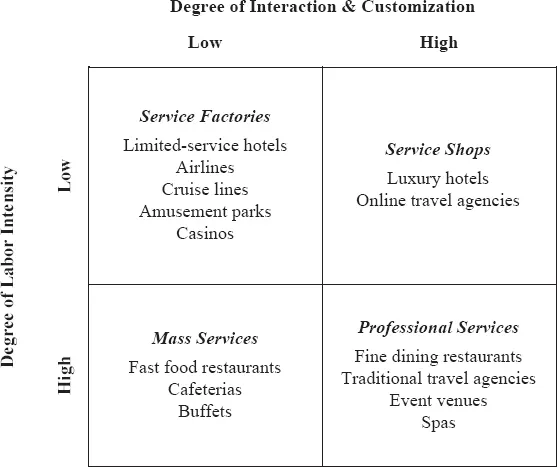
eBook - ePub
Operations Management in the Hospitality Industry
- 460 pages
- English
- ePUB (mobile friendly)
- Available on iOS & Android
eBook - ePub
Operations Management in the Hospitality Industry
About this book
From restaurants to resorts, the hospitality industry demands strong operations management to delight guests, develop employees, and deliver financial returns. This introductory text provides students with fundamental techniques and tools to analyse and improve operational capabilities of any hospitality organization.
This book spans a breadth of topics critical to today's operations leaders. Each topic surveys key theories, frameworks, and industry examples, with additional depth achieved through engaging learning features.
Uniquely, the book is set out in standalone chapters that can be digested individually or together; allowing flexibility for instructors and readers seeking to learn specific subject matter. Whether a student preparing for their career, or a professional seeking tools, readers will gain valuable knowledge from Operations Management in the Hospitality Industry.
Frequently asked questions
Yes, you can cancel anytime from the Subscription tab in your account settings on the Perlego website. Your subscription will stay active until the end of your current billing period. Learn how to cancel your subscription.
No, books cannot be downloaded as external files, such as PDFs, for use outside of Perlego. However, you can download books within the Perlego app for offline reading on mobile or tablet. Learn more here.
Perlego offers two plans: Essential and Complete
- Essential is ideal for learners and professionals who enjoy exploring a wide range of subjects. Access the Essential Library with 800,000+ trusted titles and best-sellers across business, personal growth, and the humanities. Includes unlimited reading time and Standard Read Aloud voice.
- Complete: Perfect for advanced learners and researchers needing full, unrestricted access. Unlock 1.4M+ books across hundreds of subjects, including academic and specialized titles. The Complete Plan also includes advanced features like Premium Read Aloud and Research Assistant.
We are an online textbook subscription service, where you can get access to an entire online library for less than the price of a single book per month. With over 1 million books across 1000+ topics, we’ve got you covered! Learn more here.
Look out for the read-aloud symbol on your next book to see if you can listen to it. The read-aloud tool reads text aloud for you, highlighting the text as it is being read. You can pause it, speed it up and slow it down. Learn more here.
Yes! You can use the Perlego app on both iOS or Android devices to read anytime, anywhere — even offline. Perfect for commutes or when you’re on the go.
Please note we cannot support devices running on iOS 13 and Android 7 or earlier. Learn more about using the app.
Please note we cannot support devices running on iOS 13 and Android 7 or earlier. Learn more about using the app.
Yes, you can access Operations Management in the Hospitality Industry by Peter Szende, Alec N. Dalton, Michelle (Myongjee) Yoo, Peter Szende,Alec N. Dalton,Michelle (Myongjee) Yoo in PDF and/or ePUB format, as well as other popular books in Business & Hospitality, Travel & Tourism Industry. We have over one million books available in our catalogue for you to explore.
Information
Chapter 1
Understanding Service Operations Strategy
Abstract
This chapter covers four main concepts: (a) providing an understanding of service; (b) organizing hospitality decisions and processes; (c) defining strategic service visions; and (d) dissecting operations strategies for hospitality services. In the first section, the definition of service, the five service dimensions, and the service package are covered. In the second section, hospitality decisions and processes are framed by service concepts and the service-profit chain. A service concept is the starting point for developing hospitality operations strategies, while the service-profit chain explains the link from customer satisfaction and customer loyalty to a service firm’s growth and profitability. In the third section, the strategic service vision is explored. Successful service firms all have a strategic service vision, which includes a set of ideas and actions organized in a systematic way to maximize a firm’s performance. In the fourth and final section, the operations strategy for hospitality services is covered. Successful service operations occur when management defines and adheres to a competitive operations strategy.
Keywords: Hospitality operations management; operations strategy; service; service decisions; service process; strategic service vision
Learning Outcomes
After completing this chapter, you should be able to:
- Classify services to understand common and variable managerial issues across hospitality businesses.
- Describe a hospitality service using the five dimensions of the service package.
- Articulate the service concept for a hospitality organization to develop operations strategies.
- Explain the service-profit chain for a hospitality organization.
- Formulate a strategic service vision framework for a hospitality organization.
- Identify the competitive dimensions of operations strategy for a hospitality organization.
Outline
- What Is “Service”?
- 1.1. Definition of Services
- 1.2. Dimensions of Services
- 1.3. The Service Package
- Hospitality Decisions and Processes
- 2.1. Service Concepting
- 2.2. Service-profit Chain
- The Strategic Service Vision
- 3.1. Elements of the Strategic Service Vision
- Operations Strategy for Hospitality Services
- 4.1. Competitive Dimensions of Operations Strategies
Getting Started
The hospitality industry contributes to a significant portion of the service sector, and its growth had been constantly accelerating over the past decade leading to the COVID-19 pandemic. Since 2009, the US hospitality industry developed steadily and total revenues surpassed $1.6 trillion in 2017, supporting 7.8 million jobs (National Travel and Tourism Office, 2018). While COVID-19 substantially stunted industry growth, the crisis also illuminated the significance of the industry to national and global economies.
It is important to note at the beginning of this chapter that this book specifically focuses on the hospitality industry in terms of operations management. The hospitality industry extends beyond the most prominent sectors of hotels and restaurants: hospitality broadly includes lodging, food and beverage service, meetings and events facilitation, theme parks and amusements, casino gaming, clubs of several types, and a variety of travel services – air, rail, automotive, and cruising among them. To deliver experiences in any of these sectors, a critical business function is needed: hospitality operations management seeks to profitably coordinate the design, development, and delivery of service experiences. It includes all of the activities, decisions, and responsibilities for business success by utilizing company resources. These resources involve the employees, equipment, technology, and even the customers. Effective operations management can make a real difference for hospitality firms. Overall, hospitality operations management is concerned with understanding customer needs, designing and delivering quality service, managing efficient and effective service processes, producing continuous service improvements, and meeting company objectives. Excellent hospitality operations management will lead to better services and experiences for customers and staff, which will further the goal of business success. This chapter intends to explain the role of hospitality operations management by first introducing some key concepts, starting with a foundational understanding of services.
1. What is “Service”?
1.1. Definition of Service
Services are abundantly experienced in daily life, and they occur in an array of styles and outcomes. Services can be provided directly to the customer (e.g., spa treatments) or for the customer (e.g., food deliveries). Services can be delivered by personnel (e.g., luggage delivered to hotel rooms by bellmen) or via technology (e.g., restaurant reservations made online by guests themselves). Generally, a service is the action, performance, or process that takes place between a customer and a service provider: a service is the intangible part of the transaction relationship, whereas a product is the tangible component. For example, at Dunkin coffee shops, guests experience the intangible service (e.g., ordering the coffee, interacting with the staff) and receive the tangible, physical product (e.g., a cup of coffee, a doughnut). Likewise, when a guest stays at a hotel, they experience the intangible service (e.g., checking in at the front desk) and engage with a tangible, physical product (e.g., the hotel room they occupy during the visit). Services surround virtually every part of consumers’ lives, and they are especially pronounced in the human-centric hospitality industry.
1.2. Dimensions of Services
In his book Service Science: Concepts, Technology, Management, Katzan (2008) outlines five dimensions on which services can be classified:
- 1) Service process;
- 2) Service nature;
- 3) Service delivery;
- 4) Service availability; and
- 5) Service demand.
Each of these dimensions offers a spectrum on which businesses can determine and distinguish operations strategies. Collectively, the dimensions help to define the overall service model for a business.
The dimension of service process captures the relationships between the labor intensity of a service and how much the service is customized. Schmenner (1986) developed the service process matrix (Fig. 1) to visualize the relationships.
The Y-axis represents the degree of labor intensity, or the significance of labor costs relative to capital (e.g., equipment, software) costs. The X-axis reflects the degree to which each service interaction is customized for the guest. Service factories are businesses like airlines or cruise lines that employ heavily standardized processes (often driven by technology) to deliver generic services to many guests. Professional services, like spas or fine dining restaurants, are at the opposite end of the spectrum: these businesses offer highly customized services to guests, and the services require the devotion of significant time by trained professionals in order to create the experiences. Service shops may not require as much labor (relative to capital costs), but they still achieve high personalization; think about the way luxury hotels customize the stays of large numbers of guests staying each evening. Mass services, finally, offer little customization but still require heavy labor: this is especially common in foodservice, where large volumes of standard food items might need to be prepared for large numbers of guests. The four quadrants of the matrix ultimately represent the four dominant schemes for service processes.

Fig. 1. The Service Process Matrix. Source: Adapted from Schmenner (1986, p. 25). Copyright 1986 by the Sloan Management Review Association.
The service nature dimension characterizes how a service acts upon an object to achieve a result. A service object is the person or thing upon which the service is enacted. The service result is the tangible or intangible outcome of the service. The service nature matrix (Fig. 2) maps these dimensions.
In hospitality businesses, it is most common that the service objects are people. Service results, however, can vary between being tangible or intangible. While many services involve tangible items (e.g., printed h...
Table of contents
- Cover
- Title
- Chapter 1. Understanding Service Operations Strategy
- Chapter 2. Designing Service Experiences
- Chapter 3. Designing Service Environments
- Chapter 4. Forecasting Demand
- Chapter 5. Inventory Control
- Chapter 6. Managing Supply Chains
- Chapter 7. Organizing Staff
- Chapter 8. Managing Capacity and Waits
- Chapter 9. Measuring Quality
- Chapter 10. Improving Effectiveness and Efficiency
- Index